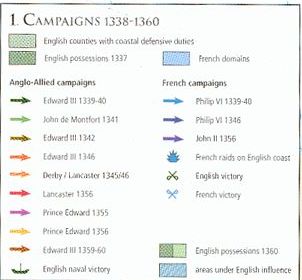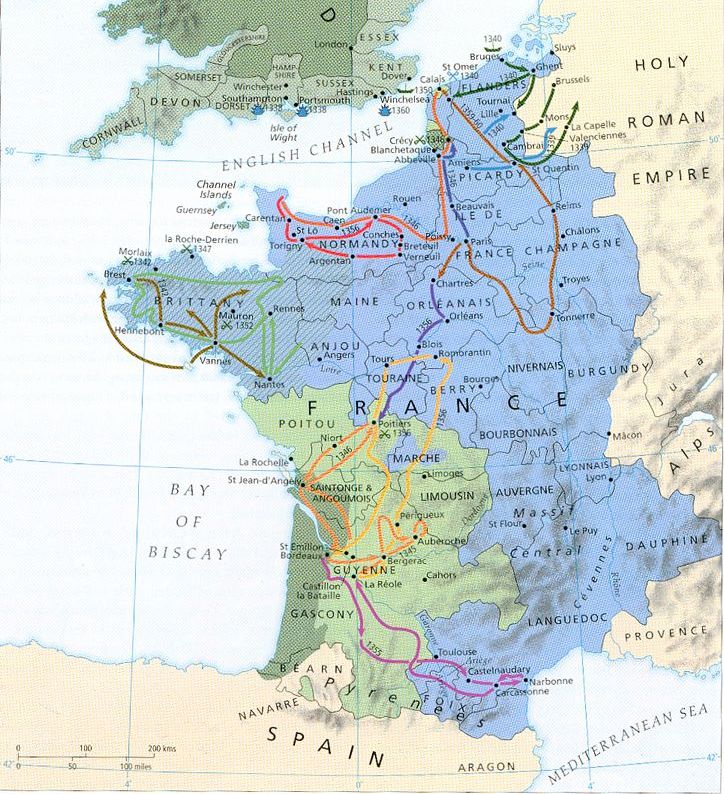 |
 |
| In
1337, the military reputation of England was not high, but they soon
became the most feared troops in Europe.
The battle tactic of dismounting men-at-arms and combining
them with flanking archery, developed against the scots provided
almost unbeatable. Numbers
of archers grew during the war from one to one or less in proportion
to men-at-arms, to two to one or more.
In addition, English armies were very mobile.
Experience in Scotland and Ireland had developed the hobilar,
a light horseman useful in raids.
A rising proportion of archers served mounted, as their
status and income rose, squeezing out peasant participation.
English armies increasingly served for pay through
‘indenture’, whereby captains, ranging from great lords to
esquires, contracted to provide an agreed number of men.
This was a flexible system well-suited to overseas
expeditions, and called ‘professional’ armies. |
|
In
contrasts, French armies depended heavily upon the military
obligations of the chivalrous classes, providing men-at-arms, and a
levied infantry or town militias, often of poor quality.
Missile-men were commonly Genoese mercenary crossbowmen,
drawn from the royal fleets. Such
forces proved difficult to muster, being tied down in garrison duty,
and being tactically inflexible in the face of the English
‘system’.
Certainly
English tactics were crucial in providing victories, often against
the odds, but this does not mean that the English strategy of
chevaucje was a battle-seeking one. The chevauchies resulting in the battles of Crecy (1346) and
Poitiers (1356) were untypical, although both gave Edward important
political advantages. The
chevauchies of the 1370’s and 1380’s were less successful.
The French had learnt not to offer battle, and the English
gained no fortifications. |
| |

|
|
|
1340 saw the
first real conflict between France and England with the Battle of
Sluys. The outcome of
this was a decisive English naval victory, but the following land
campaign achieved no more than an unsuccessful siege of Tournai.
These costly expeditions bankrupted the English government
and forced them to change strategy.
England adopted, for the next two decades, a style of
guerrilla warfare. The English established oppressive ransom
districts to support their garrisons in Brittany, whose captains
made fortunes.
In April
1356, John II (king of France since 1350) arrested Charles, king of
Navarre, for treachery. This
brought Philip of Navarre, Charles’ brother, into Edward’s camp,
this was a useful ally as the brothers’ estate included parts of
Normandy. Edward
seizing his chance redirected his troops, under Henry of Lancasters
command, intended for Brittany to Normandy, were they joined forces
with other ally units and lifted the siege of Pont Audemer, from
there they swept south via Breteuil, Conches and Verneuil were King
John mustered troops to slowly to oppose them. They continued to march south via Argentian then Torigny.
Lancaster then launched another chevauchee out of Brittany to join
up with prince Edward, who was advancing north from Bergerac. Edward spent 7-11 August at Tours, probably waiting for
Lancaster, whose advance was barred by the swollen Loire River.
Unaware of this Edward got trapped just south of Poitiers by
King John, who had learnt of Edwards’s positions by prisoners he
had captured. Edward
took up a strong position and was able to nullify John’s numerical
superiority and then managed to capture the French King (19
September 1356) and hold him for ransom.
Edward was
provoked in 1359 to invade North France again, over royal ransom
wrangling. He intended to take Reims and be crowned king there.
When the city defied siege, Edward, ever the opportunist,
gave up his claim to the French throne in return for confirmation of
the widest extent of lands held by the English crown for 200 years
(Treaty of Bretigny, 1360) His
original aim of securing Gascony had been greatly exceeded as the
campaigns of the 1340’s created their own momentum of plunder and
glory, and the windfall of King John’s capture gave him a trump
card in negotiations. His
strategy had won huge gains, but it was not to prove fallible.
|
|